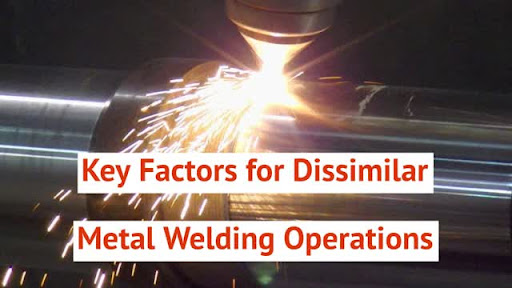
Before any welding operation can begin, the welder must identify the unique characteristics of each material (Chemistry, melting point, thermal expansion, etc.) and choose the welding method that suits them. When welding different metals together, this typically requires expert knowledge and skills. The right welding method wielded by an experienced welding provider can make it possible to join even the most difficult-to-weld materials.
What Is Dissimilar Metal Welding?
Dissimilar welding refers to welding processes that join different metal alloys. This short article will briefly compare fusion arc welding with laser cladding or laser weld overlay welding.
Can Dissimilar Metals Be Welded?
It is possible to weld dissimilar metals. However, there are many factors that must be considered to ensure the formation of a joint with adequate strength for the intended application. For these reasons, it is essential to partner with a laser welding provider that has experience welding dissimilar metals so you can know you can trust them to address all of the factors appropriately.
Key Factors for Dissimilar Metal Welding Operations
Some of the key factors to keep in mind for dissimilar metal welding operations include:
- Dilution and Alloying: During welding of dissimilar metals, the metals will have to have a solid solution in which the mixture will produce stable metallurgical phases. These can be 1 or more phases. The phase is determined by the amount of dilution.
- Weldability level: When dissimilar metals are joined, excess dilution can lead to a high risk of Hot cracking also know as solidification cracking. Weldability measures the capacity of one metal to be joined to another without such cracking.
- Electrochemical characteristics: During dissimilar metal welding operations, there is a risk of corrosion developing at the part of the joint where the metals transition from one to the other (i.e., the intermetallic zone) or the overlay surface itself. If the metals have significantly different electrochemical properties due to dilution, the corrosion risk is high.
- Melting point: Different metals may melt at different temperatures. So welders need to use a welding process [Pre Heating] that quickly brings all metals to their melting points or a welding process that doesn’t require any of them to melt.
- Coefficient of thermal expansion: Metals Expand upon heating and therefore change their shape and size when they are heated. If two metals being welded change shape at different rates or to different degrees, it can strain the weld as it sets resulting in thermal cracking.
- Heat affected Zone: heat affected zones immediately next to the weld can have significantly different physical properties than the original base metal. For high carbon or cast iron this primarily higher hardness. This can lead to reduced toughness and brittle fracture.
Arc Versus Laser Welding to Join Dissimilar Metals
Millions of man hours and years of research have been dedicated in developing weld procedures for fusion ARC welding corrosion resistance alloy and then joining together these dissimilar components to prevent degradation of strength, toughness, and corrosion resistance.
This traditional welding method most used for joining dissimilar metals is fusion ARC welding. It encompasses traditional welding processes, such as tungsten inert gas (TIG) welding (i.e., gas tungsten arc welding or GTAW) and metal inert gas (MIG) welding (i.e., gas metal arc welding or GMAW).
For laser cladding or laser weld overlay, the physical attributes of lasers, when used as welding heat source, are such that the negative effects of the key factors described above are significantly reduced in their influence. These factors are the primary driver for developing the welding essential variables for a welding procedure qualification. The essential welding process variables are significantly reduced in number and in some cases eliminated entirely.
The laser Cladding of dissimilar materials benefits are:
- Laser weld overlay is not as sensitive to different melt temperatures.
- Very low dilution
- Allows for much thinner clads.
- Reduces sensitivity to thermal expansion issues.
- Allows for control of detrimental metallurgical phases.
- Reduces or eliminates of solidification cracking [Hot cracking]
- high corrosion resistance can be achieved in a single thin layer.
- Elimination of multiple layer requirement to attain necessary chemistry.
- Less pre-Machining
- Allows for much thinner clads.
- Small heat affected zone = less distortion
- Allows overlay onto high hardenability materials without preheat.
- preheat requirements significantly reduced are eliminated.
- Laser can overlay ductile cast iron without significant preheat.
- Post weld heat treatment significantly reduce are eliminated.
- High quench rates = finer grain structure = higher corrosion potentials
Laser as the heat source is the ultimate tool for welding/cladding dissimilar materials.
What Metals Cannot Be Welded?
Material compatibility and incompatibility depend on the welding method used. For example, the fusion welding method cannot be used for the following metal combinations:
- Aluminum and carbon steel
- Aluminum and copper
- Aluminum and stainless steel
- Titanium and steel
In these cases, the alternative method to fusion joining is non-fusion welding. It encompasses processes such as diffusion bonding, explosion welding, ultrasonic, and friction welding. They are suitable for joining the above metal combinations and other insoluble metals.
<Explore our guide to the laser welding process.>
Learn More About Laser Welding for Dissimilar Metals From Titanova
Want additional information on laser welding for dissimilar metals? Ask the experts at Titanova! Equipped with extensive experience providing laser processing solutions, including laser welding and cladding, to customers across a wide range of industries, we can answer or address any questions or concerns you may have about the process.
Does your next project involve laser welding or cladding? Partner with us today! We also provide autogenous laser welding capabilities for a variety of metal parts and products. Visit our laser welding page to find out more about our service offerings.


Comments are closed